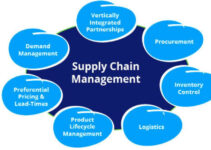Flipkart is one of the largest Indian e-commerce platforms. Binny and Sachin Bansal laid the foundation of the e-commerce platform in 2007. The main objective of the company is to make its products and goods easily available to people who have an internet connection. The E-commerce platform has established a very large SC and distribution network in order to comply with customer orders. Today, we’ll discuss Flipkart supply chain management; its definition, and key elements.
Some of the main products and services that Flipkart offers in various categories are as follows;
- Shoes
- Apparel
- Toys
- Perfumes
- Stationary
- Electronics
- Home Appliances
- Personal products
- Healthcare
- Computers
- Cameras
- Mobiles
- Games
- Music
- Movies
The annual revenue of Flipkart in 2022 was 7.7 billion US dollars, and e-commerce holds a dominant position in the Indian market in terms of market share.
Structure of Flipkart Supply Chain Management
Flipkart supply chain management structure has three main categories and they’re as follows;
- Operational area focuses on the SCM activities and tasks of the company like customer support, logistics, warehouse, and procurement
- Business developmental category manages sales and operations
- Technology and product area focuses on the ERP system and web management
The objective of the SC partners and retailers of the company is to deal with the chain network and how it is creating value for customers and the company. We can say that the supply chain of Flipkart comprises an integrated system of online retailing and SC partners.
Flipkart SCM focuses on providing high value to the customers at the lowest cost by properly managing upward and downward relationships with the business processes. The supply chain deals with all the business processes starting from sourcing and production to the consumption point. However, some of the main processes involved in SCM are as follows;
- Product development
- Manufacturing flow management
- e-procurement
- Demand management
- Service management
- Customer relationship
Key Elements of Flipkart SCM
Some of the main elements of Flipkart supply chain management are as follows;
Procurement
Flipkart implements the marketplace model where the potential buyers would directly deal with sellers; the Flipkart platform would deliver the products and goods to the customers. The e-commerce platform has included more than 50 sellers in its list. Currently, WS Retailers are managing the entire inventory of the company, and the platform calls it a pet project.
Flipkart performs the sourcing at two levels; regional and central level; the procurement team of the company manages the two levels. Every regional procurement team has established a network of local suppliers for; just-in-time procurement and made-to-stock.
WMS (warehouse management system)
Flipkart has established a network of seven warehouses in various states across the country. They are in Delhi, Noida, Bangalore, Kolkata, Chennai, Mumbai, and Pune. However, some of the small regional distribution facilities are in more than 500 cities WMS of the e-commerce platform comprises the 3 main areas;
- Products Packing – it is the stage and area where you pack the products for customers
- Scan and Quality Checks – analyzing the quality of the goods received
- Inward Processing – it is when you make the physical delivery of products
Logistical Operations
According to an estimate, Flipkart delivers and ships roundabouts more than 100 thousand products and goods to the customers. It makes logistics and financial management a very difficult and complex issue and problem for the company. Flipkart launched EKL (eKart) in 2013; an in-house logistics center and it helps the company to approach customers in more than 150 cities across the country.
eKart offers the following services;
- Analysis
- Billing
- Reporting
- Customer notification
- Order tracking
- Customer support and integration technology
- Pay on delivery
- Reverse logistics
- Delivery logistics
Approximately 90% of the company’s deliveries and shipments are cash on the delivery (COD ) model; EKL performs 60-70% of deliveries of the company. The company performs the remaining 30% of the shipment and delivery through 3PL.
Reverse Logistics
Flipkart follows the 30-day return policy in its reverse logistics; it allows the company to establish trust and confidence with customers. The returned products from customers have to follow any of the routes and paths;
- Store Credit: unsatisfied customers would receive the same credit from the store
- Replacement: the platform returns the package to the suppliers and they send the replacements to the customers
Supplier Management
Flipkart finds and finds the new category of products and goods from distributors and local suppliers. Wholesalers and manufacturers would directly approach you once there is sufficient demand. You should keep in mind the percentage of returns, quality checks, and supplier prices.
Differentiating Factors
The success of the Flipkart marketplace model happens due to the following reasons;
- Procurement model
- Robust logistics
- Efficient delivery system
- Organized and well-managed warehousing
Challenges to FlipKart SCM
Some of the main challenges to Flipkart SCM are as follows;
- Customer acquisition cost is very high
- High attrition rate
- A limited number of quality and talented people
- Competition from the new entrants
- Average and low internet broadband speed in India compared to other countries
- Internet penetration and growth rate is very low in the world
Conclusion: Flipkart Supply Chain Management
After an in-depth study of Flipkart supply chain management; we have realized that Flipkart has established a very efficient SCM and logistics system. If you are learning about Flipkart SCM, then you should keep in mind the abovementioned elements, differentiating factors, and challenges.
Ahsan is an accomplished researcher and has a deep insight in worldly life affairs. He goes Live 3 days a week on various social media platforms. Other than research writing, he’s a very interesting person.


